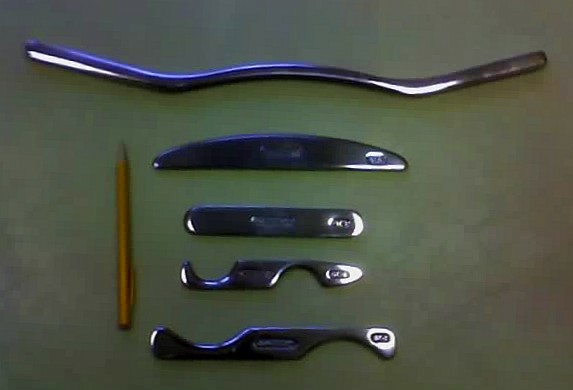Instrument-Assisted Soft Tissue Mobilization: A Systematic Review and Effect-Size Analysis
Seffrin CB, Cattano NM, Reed MA, Gardiner-Shires. J Athl Train. 2019 [Epub ahead of print]
Take Home Message
Instrument-assisted soft tissue mobilization (IASTM) may improve range of motion in healthy individuals as well as pain and patient-reported function in people with an injury. Clinicians should consider whether the evidence is available for their specific treatment protocol, desired outcome, and patient population.
Summary
Instrument-assisted soft tissue mobilization (IASTM) is a manual technique similar to cross-friction massage that relies on hard tools to promote healing. Unfortunately, we lack a systematic review that examines multiple outcome measures (e.g., pain, strength). Therefore, the authors of this systematic review included 13 randomized control trials that measured range of motion, pain, strength, or patient-reported function to determine the effectiveness of IASTM. The trials included a variety of ages (high school to middle age), activity levels (sedentary to competitive athletes), IASTM instruments, and treatment targets (upper or lower extremity, thoracic spine). Six studies included uninjured participants, and each of the study’s authors measured range of motion at various joints. Authors from 4 out of 6 trials found immediate and short-term (< 4 weeks) improvements in range of motion, especially shoulder horizontal adduction and hip/knee flexion with IASTM compared to stretching or foam rolling. Authors from 7 studies recruited injured participants, where one group assessed range of motion, 4 measured strength, and 6 evaluated pain and patient-reported function. Among participants with an injury, IASTM demonstrated consistent pain improvement over time and improved patient-reported function after the first week. However, the authors found that IASTM failed to improve range of motion in patients with carpal tunnel syndrome compared to soft tissue mobilization. Only 2 groups found that grip or squat strength improved with IASTM compared to eccentric exercises/stretching or control/sham, respectively. However, it is unclear if the strength changes were meaningful improvements.
Viewpoints
This systematic review is informative as it is the first to include only randomized control trials and several outcome measures of IASTM in both healthy and injured participants. The authors found that IASTM improved range of motion in a healthy population as well as pain and patient-reported function in people with an injury. However, more trials are needed to support claims that IASTM can promote strength improvement. The systematic review highlighted the variety of IASTM tools, treatment times, comparison groups, and patient populations used to test IASTM. It is a reminder that unlike medications, which are thoroughly vetted in clinical trials to receive an indication for use, our therapeutic tools/modalities rarely receive enough testing to justify their proposed benefits for certain people before going to market. Hence, clinicians should consider the evidence for their specific tools, treatment plan, and patient to decide whether IASTM is appropriate. Ideally, as more clinical trials emerge, we will be able to offer more concrete evidence for specific treatment protocols for certain patient populations. Currently, medical professionals may consider IASTM as a technique to possibly improve range of motion among healthy individuals and patient-reported outcomes among people with an injury.
Questions for Discussion
Do you use IASTM? If so, when are you most likely to utilize IASTM? Do you use IASTM in both healthy and injured patients?
Written by: Jane McDevitt
Reviewed by: Jeffrey
Driban
Related Posts
Hands on Approach to Massage Wins Over Instruments



I have seen IASTM used in the ATR frequently. I have seen it used mainly to increase range of motion in athletes. At one of my clinical sites, my preceptor had tremendous success in increasing ROM in the shoulders of elite Men’s Gymnasts. Using a combination of exercises and IASTM we saw significant improvements in the stiff shoulders of the gymnasts. I have never seen IASTM used to try and increase strength in a patient and would like to learn more about that. IASTM is a great tool to use for increasing ROM and for chronic soft tissue injuries.
I have seen IASTM used in two different settings. I have used them in the Athletic Training room to treat tendonitis and other forms of inflammation. Yet, I have had colleagues use IASTM in the Physical Therapy Office for plantar fasciitis, delayed onset muscle soreness, and to obtain better ranges in knee replacements and frozen shoulder. I would say nine times out of ten, patients have reduced pain and better mobility immediately after the treatment. Healthy patients and injured patients alike have had similar successful outcomes post IASTM in both environments. There have been instances where the clinician raised concern because patients having minor bruising the day after, but patients say that it only hurts to touch yet the pain has reduced significantly. During preseason football at my clinical site, an FCS program, I had several athletes ask for IASTM every other day because they felt it was helping prevent some of the overuse injuries that usually come with the rigors of their sport. I would like to see what IASTM could do for prevention.